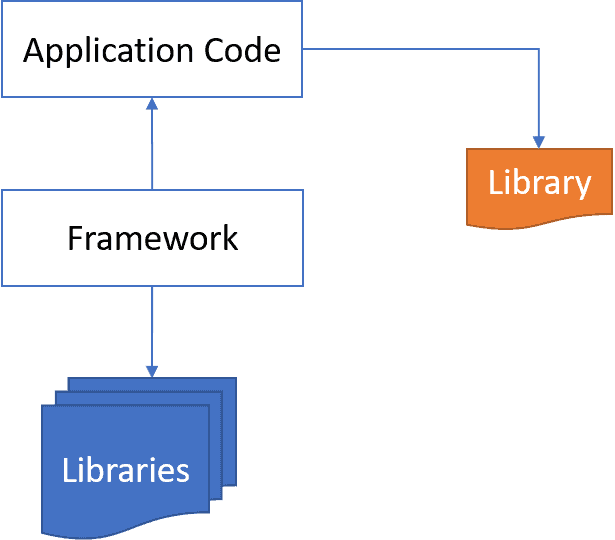1. 引言
在开发过程中,很多开发者会把“框架(Framework)”和“库(Library)”这两个术语混用。但其实它们在技术实现和使用方式上存在本质区别。简单来说,库实现的是特定功能,而框架则是一套方法论的体现,通常由多个库组成。
常见的库包括 React 和 jQuery,而常见的框架则包括 Angular、Vue,以及 MVC(Model-View-Controller) 和 MVP(Model-View-Presenter) 等架构模式。
2. 控制反转(Inversion of Control)
框架与库之间最核心的技术区别在于“控制权”的归属。我们来看下面这张图:

这张图说明了:
- 当使用库时,开发者自己掌控整个应用的流程,决定何时调用哪个库的方法。
- 而当使用框架时,流程由框架控制,开发者只是“插入”自己的代码,由框架来决定何时调用这些代码。
这种控制权从开发者代码转移到框架的过程,就叫做控制反转(IoC),它是框架区别于库的关键特征之一。
3. 框架是如何工作的?
框架提供了一个集成开发环境,通常包含多个低层库,用于解决通用开发问题。它的核心目标是加速应用开发,并提供基于最佳实践的模板、工具和标准。
以 GUI 框架为例,它通过事件处理器(Event Handler)来调用你的代码;而 Web 框架则通过请求-响应模型(Request-Response Model)来控制流程。对于 Web 开发来说,JavaScript 框架通常提供了一个骨架结构,帮助开发者快速搭建应用。
框架内部通常集成了大量库,为开发者提供开箱即用的功能,使得即使没有深厚编码经验的开发者也能快速上手。
3.1 框架的优势
使用框架的主要优点包括:
✅ 模块化设计:修改应用某一部分通常不会影响整体
✅ 性能优化:提供缓存机制和网络请求优化
✅ 开发效率高:用更少的代码实现更多功能
✅ 跨平台支持:适合开发多平台应用
✅ 用户体验好:支持动态、丰富的界面
✅ 结构清晰:如 Angular 基于 MVC,支持数据绑定(Data Binding)
3.2 框架的局限性
当然,框架也有其局限性:
❌ 限制灵活性:功能定制空间有限
❌ 学习成本高:需要掌握框架本身的结构和规范
❌ 依赖性强:版本更新频繁,需持续跟进
❌ 安全隐患:若不按规范开发,可能引入安全漏洞
❌ 性能问题:多个库依赖可能引发冲突
❌ 浏览器兼容性问题:某些框架依赖特定浏览器特性
3.3 框架的应用场景
框架广泛应用于以下领域:
- Web 开发:如 PHP 的 Laravel、Python 的 Django、JavaScript 的 Angular、React、Vue 等
- 人工智能:如 Apache Spark、PyTorch、Tensorflow
- 移动开发:如 NativeScript、React Native、Flutter(Google 推出的 UI 工具包,用于构建高性能原生应用)
4. 库是如何工作的?
库本质上是一组可复用、已编译、已测试的代码集合,用于增强或自动化应用功能。它服务于代码开发和编译过程,并在应用运行时提供支持。库通常封装了多个函数、变量和参数。
4.1 库的优势
使用库的好处包括:
✅ 提升性能:编译器在运行时选择性加载库
✅ 代码复用:无需重复定义函数,直接引用
✅ 节省开发时间:避免重复实现复杂功能
✅ 灵活性高:可以按需选择使用哪些库
✅ 降低开发成本:已有代码可直接复用
✅ 稳定可靠:多数库经过广泛测试和社区验证
4.2 库的局限性
虽然库灵活,但也存在一些限制:
❌ 耦合风险:一旦依赖某个库,替换成本较高
❌ 兼容性问题:不支持的环境需引入包装层,影响性能
❌ 维护依赖:库停止维护可能导致兼容问题
❌ 性能瓶颈:多库依赖可能导致冲突
❌ 安全风险:部分库可能存在漏洞
4.3 库的典型应用场景
库的应用非常广泛,例如:
- jQuery:简化 DOM 操作、事件处理、动画和 Ajax 请求
- Lodash:提供实用的函数式编程工具
- Axios:用于发起 HTTP 请求的库
- Moment.js:处理日期时间格式化等操作
5. 框架 vs 库:核心区别
| 特性 | 框架(Framework) | 库(Library) |
|---|---|---|
| 功能定位 | 提供工具、标准、模板和政策,用于快速开发 | 提供可复用的函数 |
| 控制权 | 框架决定何时调用库 | 开发者决定何时调用库 |
| 使用方式 | 需遵循框架规范新建项目 | 可直接引入现有项目中 |
| 开发效率 | 易于创建和部署完整应用 | 便于功能绑定和复用 |
| 目标 | 减少开发复杂度 | 提供可复用的功能 |
| 灵活性 | 相对较低 | 更高 |
| 学习曲线 | 通常较陡峭 | 相对平缓 |
6. 总结
本文从技术角度详细讲解了框架与库之间的区别。
✅ 框架更适合从头构建一个结构清晰、功能完整、可维护性强的应用。它提供了一套开发方法论,帮助开发者快速上手,但也意味着需要遵循其规范和结构。
✅ 库则更灵活,适合在已有项目中按需引入,增强特定功能。它不强制你遵循某种结构,但也不提供整体架构层面的支持。
📌 一句话总结:
“框架告诉你怎么做,库告诉你怎么做某件事。”
根据项目需求和技术栈选择合适的工具,才能真正提升开发效率和产品质量。